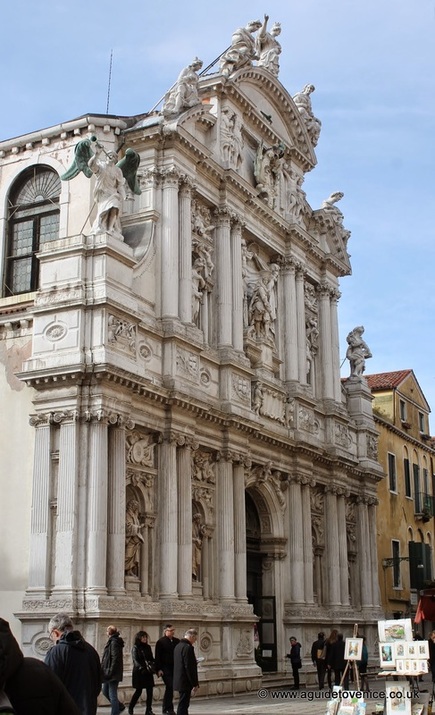Santa Maria del Giglio
Open: Mon-Sat: 10-17.
Santa Maria del Giglio was founded in the 10th century by the Jubanico family, hence the church's other name, Santa Maria Zobenigo.
Santa Maria Zobenigo was rebuilt in the second half of the 17th century with funds from the Barbaro family. The interior of the church, which was designed by Giuseppe Benoni, comprises a nave with side chapels and a simple presbytery.
The richly decorated façade (1680-83), the work of the Venetian architect Giuseppe Sardi, is, in effect, the funerary monument of Antonio Barabaro, Capitano da Mar, who died in 1679. Barbaro willed 30,000 ducats to be spent on completing the church, which was intended to be a glorification of his family. His statue by Giusto Le Court stands above the entrance, flanked by statues of Honour and Virtue. In the lower niches stand full-length statues of his four brothers. The six relief maps, at the bases of the columns, depict the cities (Zara, Crete, Padua, Rome, Corfu, Split) where the Capitano held administrative or ambassadorial posts.
John Ruskin described the façade as a "manifestation of insolent atheism."
Santa Maria del Giglio is home to the only painting in Venice by the great Flemish artist, Peter Paul Rubens.
Santa Maria Zobenigo was rebuilt in the second half of the 17th century with funds from the Barbaro family. The interior of the church, which was designed by Giuseppe Benoni, comprises a nave with side chapels and a simple presbytery.
The richly decorated façade (1680-83), the work of the Venetian architect Giuseppe Sardi, is, in effect, the funerary monument of Antonio Barabaro, Capitano da Mar, who died in 1679. Barbaro willed 30,000 ducats to be spent on completing the church, which was intended to be a glorification of his family. His statue by Giusto Le Court stands above the entrance, flanked by statues of Honour and Virtue. In the lower niches stand full-length statues of his four brothers. The six relief maps, at the bases of the columns, depict the cities (Zara, Crete, Padua, Rome, Corfu, Split) where the Capitano held administrative or ambassadorial posts.
John Ruskin described the façade as a "manifestation of insolent atheism."
Santa Maria del Giglio is home to the only painting in Venice by the great Flemish artist, Peter Paul Rubens.





